| Pages:
1
2 |
Tacho
National Hazard
   
Posts: 582
Registered: 5-12-2003
Member Is Offline
Mood: No Mood
|
|
Chromatotron - radial chromatography.
I read a Nicodem's post where he mentions "radial chromatography". Since I had never heard of it, I did a search and... what a clever idea! How come
no one ever mentioned it here?
Chromatotron
US patent # 4139458
Has anyone ever worked with one of these? I can't see how it feeds the solvent. The patent mentions a wick, but I would like to hear from someone with
first hand experience. Is it that simple? just a wick touching a circular spinning adsorbent? Looks like a simple project for DIY.
Details please...
|
|
|
ziqquratu
Hazard to Others
  
Posts: 385
Registered: 15-11-2002
Member Is Offline
Mood: No Mood
|
|
I've used them quite extensively. If you look at the picture you posted, the funnel feeds solvent to the centre of the plate. Underneath that inlet is
a wick, which touches the plate (there's some uncoated glass in the centre, which is what the wick touches. It doesn't touch the silica layer)
allowing solvent to run on freely. The neatest part about it is that i you use fluorescent silica, you can use a UV lamp to watch your compounds
separate (assuming they show up). You can then simply collect as they come off, wash the plate (we use 10% MeOH in EtOAc) and reuse.
It would be reasonably simple to make one. When I get a chance (next week some time) I'll take some pictures if you'd like, so you can see exactly
what it is.
|
|
|
Tacho
National Hazard
   
Posts: 582
Registered: 5-12-2003
Member Is Offline
Mood: No Mood
|
|
Thank you ziqquaratu. I am surprised that this device was never mentioned here at SMDB. I'm not a chemist and I have never used a chromatographic
column, but it seem to exist consensus that those things are a pain to prepare and use. The chromatotron sounds like fun to use. I would love to see
some pictures if you have the chance to take them. Especially of the wick arrangement. I have the feeling that that would be the Achilles heel of a
homemade device.
For those who don't know it and didn't bother to click on the link, the Chromatotron is a desktop device to chromatographycally separate components of
a mixture using a spinning circular TLC plate. Unlike the TLC, however, it collects the elutes. Besides, it is fast and fully reusable, not to
mention that you don't have to refill the column every time you want to change the packing, you just change disks.
At least that is how I think it is.
|
|
|
PHILOU Zrealone
International Hazard
    
Posts: 2893
Registered: 20-5-2002
Location: Brussel
Member Is Offline
Mood: Bis-diazo-dinitro-hydroquinonic
|
|
Wow, I would like to build one....but I need to know what are typical rotor speed and how the exhaust fluid is gathered into a single sink. I think it
has to do with the slope of the disk. Fluid goes out mostly at the lowest point then...
Speed must be fast but not too much in a way it doesnt splater all arround...that's the point...
PH Z (PHILOU Zrealone)
"Physic is all what never works; Chemistry is all what stinks and explodes!"-"Life that deadly disease, sexually transmitted."(W.Allen)
|
|
|
Tacho
National Hazard
   
Posts: 582
Registered: 5-12-2003
Member Is Offline
Mood: No Mood
|
|
| Quote: | Originally posted by PHILOU Zrealone
Wow, I would like to build one....but I need to know what are typical rotor speed and how the exhaust fluid is gathered into a single sink. I think it
has to do with the slope of the disk. Fluid goes out mostly at the lowest point then...
Speed must be fast but not too much in a way it doesnt splater all arround...that's the point... |
The patent gives you all those details. Only the wick thing puzzles me.
|
|
|
microcosmicus
Hazard to Others
  
Posts: 287
Registered: 31-12-2007
Member Is Offline
Mood: spin up
|
|
The patent said 700 r.p.m. for a machine with a 165 mmm disk. (next to last paragraph of
the patent) Hopefully ziqquratu can expand on that with some real life experience. In particular,
I would like to know whether the contraption comes with variable speeds or whether a
single speed suffices.
As for where the exhaust fluid goes, have a look at the patent. Spending a few minutes
perusing drawings 3 and 4 should go a long way towards answering your question.
http://www.google.com/patents?vid=USPAT4139458
[Edited on 28-2-2008 by microcosmicus]
|
|
|
not_important
International Hazard
    
Posts: 3873
Registered: 21-7-2006
Member Is Offline
Mood: No Mood
|
|
Yes, the trick is to shape the outer wall so as to avoid splattering, and to form a trough that collects the droplets and lets the liquid to the
outlet tap. Cute device, surprised it didn't get more attention.
|
|
|
jokull
National Hazard
   
Posts: 506
Registered: 22-2-2006
Location: Everywhere
Member Is Offline
Mood: Ice glassed
|
|
I think your talking about somthing like this:
http://www.analtech.com/cyclograph.html
I used to operate such an equipment, it uses a step motor in the 1200/1450 rpm range.
|
|
|
Tacho
National Hazard
   
Posts: 582
Registered: 5-12-2003
Member Is Offline
Mood: No Mood
|
|
| Quote: | Originally posted by jokull
I think your talking about somthing like this:
http://www.analtech.com/cyclograph.html
I used to operate such an equipment, it uses a step motor in the 1200/1450 rpm range. |
US$ 8.000,00 for a basic unit?!?! Wow! No wonder it's not more popular.
|
|
|
Nicodem
Super Moderator
      
Posts: 4230
Registered: 28-12-2004
Member Is Offline
Mood: No Mood
|
|
I'm pretty sure you can get them new for 1000-2000 EUR from some producers. They are pretty common in organic labs so I would not be surprised if you
can get some used and/or slightly malfunctioning one from internet auctions. They can be made DIY and I saw one such homemade which works just nice.
The stationary phase is SiO2 with some CaSO4 (I think ~5%) and fluoroscein (it can be bought premixed). The plates must be prepared using a special
protocol and equipment (scrapes) which can also be all homemade. The mobile phase addition trough a wick touching the rotating plate is just that,
nothing special about it. The cover is necessary to maintain vapor saturation or else the mobile phase just evaporates off due to the wind from the
fast rotation. I don't know what the transparent plastic window on the cover is made from, but it has to be transparent to UV light as well. The only
drawback is that normal 2 mm thick plates can only be loaded with 1/4 gram material utmost or else the compounds generally don't separate well
(depends also on Rf differences, of course).
…there is a human touch of the cultist “believer” in every theorist that he must struggle against as being
unworthy of the scientist. Some of the greatest men of science have publicly repudiated a theory which earlier they hotly defended. In this lies their
scientific temper, not in the scientific defense of the theory. - Weston La Barre (Ghost Dance, 1972)
Read the The ScienceMadness Guidelines!
|
|
|
Phosphor-ing
Hazard to Others
  
Posts: 248
Registered: 31-5-2006
Location: Deep South, USA
Member Is Offline
Mood: Inquisitive
|
|
Here is one for a lot less than 8 grand!
Chromatotron
at $1499 that seems to be more reasonable.
"The nine most terrifying words in the English language are: 'I'm from the government and I'm here to help.'" -Ronald Reagan
|
|
|
chemrox
International Hazard
    
Posts: 2961
Registered: 18-1-2007
Location: UTM
Member Is Offline
Mood: LaGrangian
|
|
@ziqquaratu suggests that these can be used preparatively and I'd like to hear more from him about that. How much material can you process at a time?
In what ways is it superior to flash chromatography or prep HPLC? I.e what makes it worth the outlay of somewhere between $1500 and $8K? The first
graphic suggested 1-2 g at a time could be handled yielding up to a half g per component. Is this typical? Can more be accomodated in expanded
systems? What would it take to be able to run 20g at a time?
[Edited on 28-2-2008 by chemrox]
"When you let the dumbasses vote you end up with populism followed by autocracy and getting back is a bitch." Plato (sort of)
|
|
|
Nicodem
Super Moderator
      
Posts: 4230
Registered: 28-12-2004
Member Is Offline
Mood: No Mood
|
|
| Quote: | Originally posted by chemrox
How much material can you process at a time? |
That depends on the Rf differences and plate thickness. A 2 mm plate will optimally be able to separate up to 400 mg (250 mg for sure), while a 4 mm
plate up to 1000 mg (500 mg for sure). This is assuming you have compounds with Rf differences greater than 0.1 on TLC with the same mobile phase.
Obviously, you can not load 20 g in one run. That is too much even for any normal sized column.
|
|
|
WizardX
Hazard to Self
 
Posts: 61
Registered: 11-8-2005
Location: wizardx.4shared.com
Member Is Offline
Mood: wizardx.suddenlaunch3.com
|
|
| Quote: | Originally posted by Nicodem
| Quote: | Originally posted by chemrox
How much material can you process at a time? |
That depends on the Rf differences and plate thickness. A 2 mm plate will optimally be able to separate up to 400 mg (250 mg for sure), while a 4 mm
plate up to 1000 mg (500 mg for sure). This is assuming you have compounds with Rf differences greater than 0.1 on TLC with the same mobile phase.
Obviously, you can not load 20 g in one run. That is too much even for any normal sized column. |
That said! I would advise column chromatography of 50mm wide x 1000mm (or longer) column with either pressure assisted (N2 or He gas) or vacuum
assisted elution.
This will allow greater resolution of products quantitatively and qualitatively.
Albert Einstein - \"Great ideas often receive violent opposition from mediocre minds.\"
|
|
|
vulture
Forum Gatekeeper
    
Posts: 3330
Registered: 25-5-2002
Location: France
Member Is Offline
Mood: No Mood
|
|
I fail to see the benefits of radial chromatography compared to flash chromatography, unless the compounds have very low Rf values.
It does do TLC visualisation at the same time ofcourse, which is a benefit.
One shouldn't accept or resort to the mutilation of science to appease the mentally impaired.
|
|
|
Tacho
National Hazard
   
Posts: 582
Registered: 5-12-2003
Member Is Offline
Mood: No Mood
|
|
| Quote: | Originally posted by vulture
I fail to see the benefits of radial chromatography compared to flash chromatography, unless the compounds have very low Rf values.
It does do TLC visualisation at the same time ofcourse, which is a benefit. |
As I mentioned, I have no experience with chromatographic columns but consider that the average amateur has a small space in his house for his hobby,
a cupboard or a closet, and a limited budget, not to mention limited time. If he builts a flash chomatography device, he will spend a substantial
ammount of money and have this cumbersome glass device that requires loading, cleaning and the use of lots of solvent.
Now, I think one can built a radial device with commonly available materials (cheap or scrap), keep it in a small box ready to use at any time.
Besides, he may have different disks that can be changed quickly according to his needs. I gather that re-packing a column takes some time.
|
|
|
Swany
Hazard to Others
  
Posts: 188
Registered: 11-4-2005
Location: My happy place...
Member Is Offline
Mood: Sanguine
|
|
If you do not have a drum of silica or alumina (for pesky metal complexes); several gallons of ethyl acetate, several more gallons of hexanes, a
massive still, a rotovap, and a couple boxes of TLC plates, a long/shortwave UV device, and an air compressor....
(Or a laboratory with funding)
Don't pick up flash chromotography.
I use it for almost every reaction for my research, because my work involves things that need to be cooked and form a black sludge that wont clean up
without it. I have wet dreams that involve reactions that don't need heating and products that neatly crystallize out of solution, require a wash with
water and cold ethanol and are good to go. What I really mean to say is, chromotography is amazing for nasty reactions, and is an extremely useful
tool, but for the amateur, it could get expensive.
|
|
|
ziqquratu
Hazard to Others
  
Posts: 385
Registered: 15-11-2002
Member Is Offline
Mood: No Mood
|
|
Hi everyone, finally back with pictures!
Firstly, I should answer vulture's question. Radial chromatography has several advantages over flash. First and foremost, you can use a finer grade of
silica (our flash silica is 40-63 micron, whilst our crhomatotron silica is 90% <45 micron). This means better separation from the start (always
nice to skew chromatography in your favour from the start!)
Furthermore, the plates are highly reusable, the technique requires less solvent, you eliminate the need for high pressure, you can watch you
compounds separate (assuming you use silica doped with a fluorescent dye and your compounds quench fluorescence), you can separate reasonable amounts
(4mm plate, up to 1g of material. Apparently you can make 8mm plates, which I imagine should be good for up to 2.5-3g of material), and it's just a
whole lot simpler (little need to collect fractions, you just sit there and grab your bands as they come off).
Anyways, onto the design.
First, here's a picture of the top of the thing. The lid is a metal thing in front of a UV-transparent plastic sheet. There's clips on the side to
hold the lid in place, and if you look at the lower right-hand edge, you'll see a little black thing - that's a gas inlet so you can fill the chamber
with nitrogen and separate under an inert atmosphere. Also, the silver thing in the centre is just a handle, but the crudded-up circle thing to the
right is the sample and solvent inlet port.
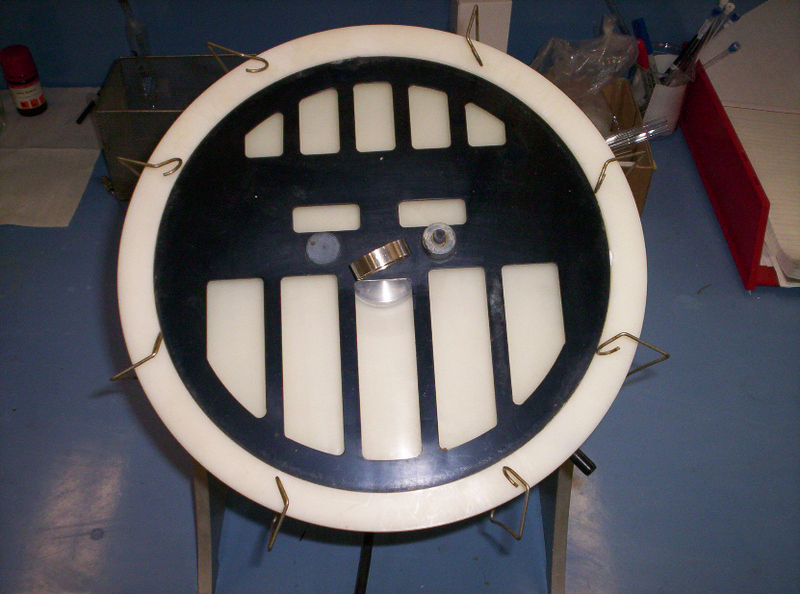
This picture is the front of the machine. The little plastic thing is the collection tube - the solvent runs out of there, you just stick a flask or
test tube or whatever under it.

This next one shows the back, just the motor. You can see it attaches directly to the chromatotron itself. All the info I cn get off it is that it's
from "Pacific Electric Motors" (Melb, Aust.), Type 8FM, 2033.
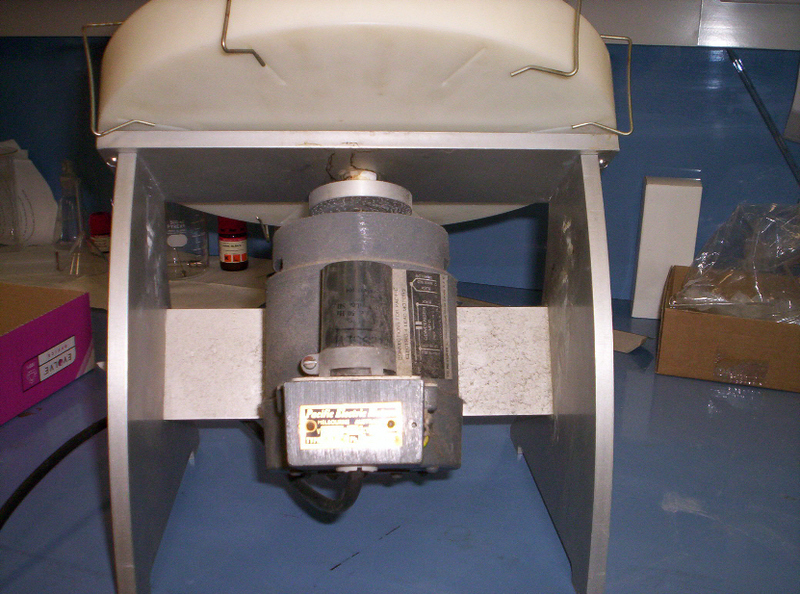
Side view (nothing much to say)
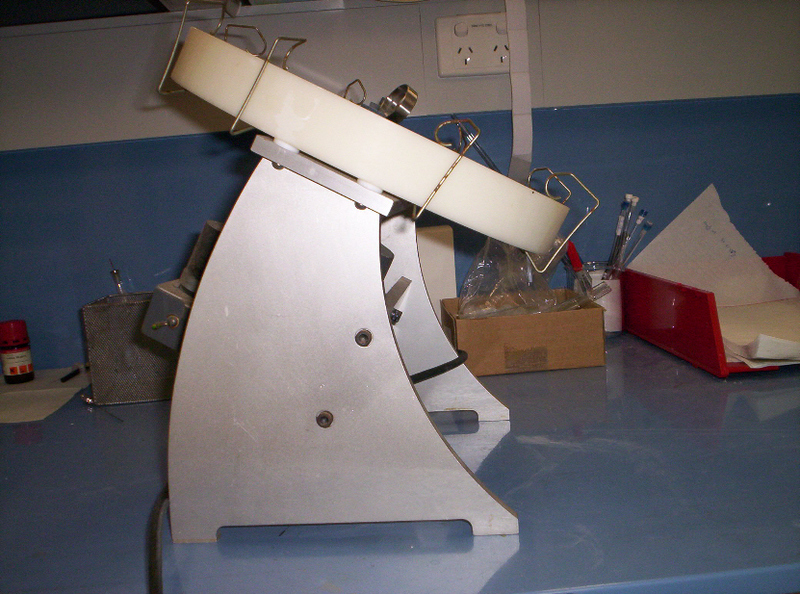
This is the underside of the lid. You can see the wick there - that's where the solvent (and sample) runs in.

Close up of the wick - nothing very special, as you can see!
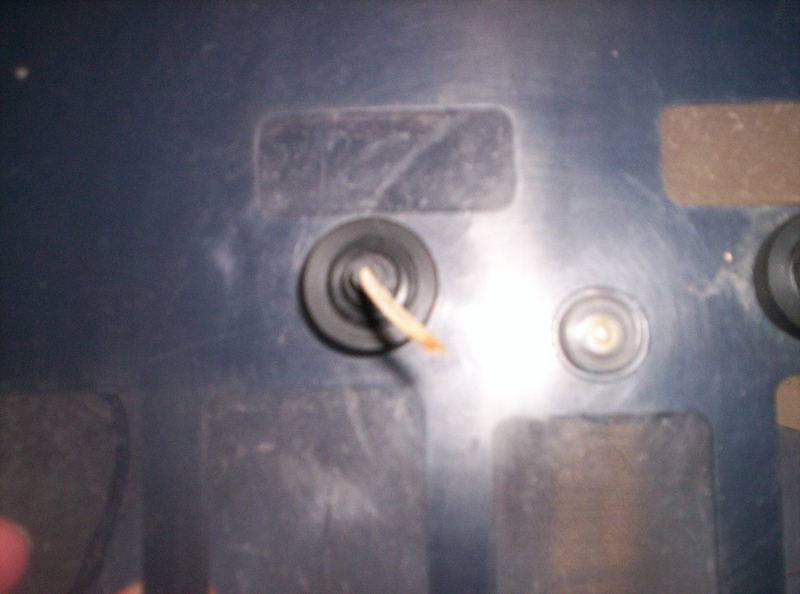
The machine lidless. You can see the "clamp" - just two metal plates, one coupled to the motor, the other screws into the first. Look at the second
photo (side-on), you see there's a teflon spacer there to cushion the glass plate. You should also see that there's a "lip" in there, which results in
a little channel sort of thing that runs all the way around the edge. This collects the solvent as it flies off the plate and allows it to run to the
bottom, where it drips out that little tube I showed before.

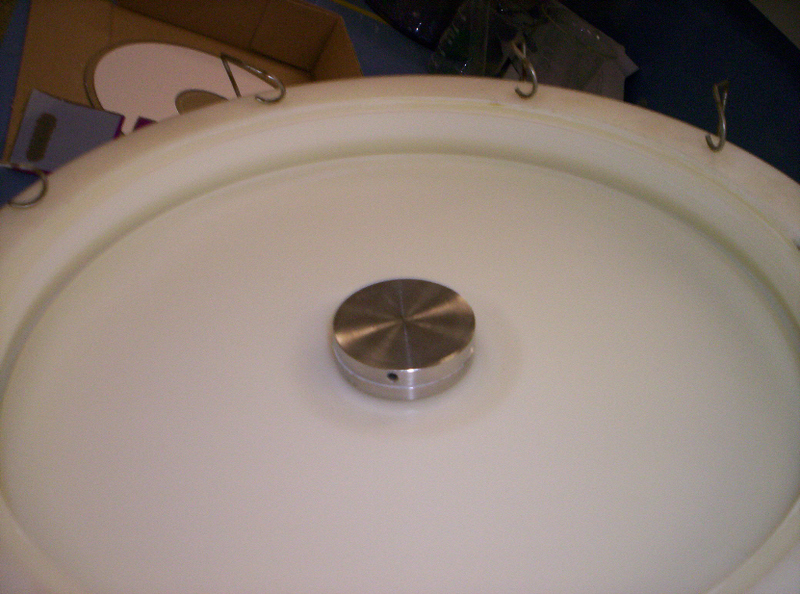
This is a freshly made plate. It's not a very good one, but anyway... I didn't make it! It's just a glass plate with a layer of silica on it. You can
see the mounting hole in the centre.

And this is the plate in the machine. Clamped in place by the metal disc in the middle.

This shows the edge (not a good one, I know, but anyway). You can see how the plate sits so that the edge is somewhat level with the centre of the
opening to that channel I mentioned, so the solvent can flick in there nicely. Bear in mind that the edge is not INSIDE the channel - there's a ~1mm
space between the edge of the plate and the "front" walls of that channel.

This last one is also average, but you should be able to see how the wick runs from the bottom of the inlet onto the glass of the plate inside the
machine. It should NOT touch the silica!
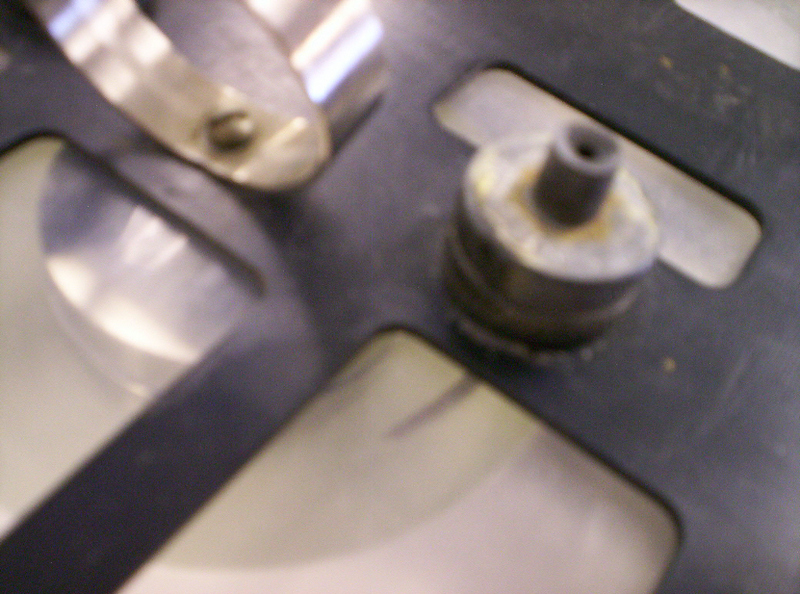
Hope that helps. If I can provide anything else, please let me know!!
EDIT: OK, I tried, I cant get the images to work... little help please? :s
Edit by Polverone: shrunk images to 800 pixels wide and fixed URLs
[Edited on 3-17-2008 by Polverone]
|
|
|
microcosmicus
Hazard to Others
  
Posts: 287
Registered: 31-12-2007
Member Is Offline
Mood: spin up
|
|
| Quote: |
Hope that helps. If I can provide anything else, please let me know!!
|
What is the diameter of the chromatography plates?
How much solvent do you use in a typical separation with,
say, a 2mm thick plate? 4mm thick plate?
Also, every time I click on one of your pictures I get a "file not found"
error, so you may need to upload them again or something.
Thank you very much for posting this, ziqquratu. In addition
to the advantages you mention, there is one particularly
relevant for me and others here . . . . . . . . . . .
   PREPARATORY CHROMATOGRAPHY FOR THE MASSES!!! PREPARATORY CHROMATOGRAPHY FOR THE MASSES!!!   
While flash cromatography and HPLC are out of the reach of most
amateurs (definitely way beyond my budget) this is a lot more
reasonable. Even if it has it's limitations, I'll gladly take
second rate chromatography over no chromatography any day.
$1500 for a new chromatotron, less for a used one is reasonable.
Someone who is mechanically inclined could build one for a
lot less --- between the patent (which is refreshingly clear and
informative) the manufacturers' data and specifications, and
the pictures and descriptions posted above, I see pretty much
everything I need to know to build one of these gizmos. If
Scientific American were still doing it's "Amateur Scientist"
columns, this sounds like exactly the sort of DIY apparatus
whose construction and use Stong would have described.
|
|
|
ziqquratu
Hazard to Others
  
Posts: 385
Registered: 15-11-2002
Member Is Offline
Mood: No Mood
|
|
Hi again... As I mentioned (it's down the bottom of my last post), I can't seem to get the images to work. I tried everything - read through the
pictures threads, and then some threads which linked to pictures in the same way I did (looked at the code when you hit the "quote" button). To be
quite honest, I can't see ANYTHING when I look at the thread - pictures, links, or otherwise!
In any case, I uploaded them to the forum FTP (the one in http://www.sciencemadness.org/talk/viewthread.php?tid=603, in a folder "chromatotron"), if anyone wants to get them separately. But maybe a
moderator could help me out? And perhaps let me know what I did wrong?
As far as plate diameter, the glass is ~24cm across, whilst the band of silica is about 7cm wide. I honestly couldn't give you an estimate of solvent
volumes required (been far too long since I ran one of these!), but it's MUCH less than required for a column.
The silica for these things is pretty cheap - around $140 per kg from Merck, which is enough for at least 10 4mm plates (more if you reactivate the
"waste" after scraping). And, of course, you could use cheaper silica for the job - that stuff is just nicely pre-prepared with the dye and binder
(CaSO4) already mixed in. Caring for the plates is pretty easy, too - keep them away from water, and wash them after use. Depending on what you're
separating, you can wash with up to 10% MeOH in EtOAc, although the MeOH will destroy the plate after a while (dissolves enough silica and CaSO4 that
the silica flies off the disc in the middle of a run - personal experience!)
Preparation is pretty simple too... I'll try and find the guide to preparing the plates (I think it might be a Merck publication too), or I'll scan a
copy when I have time. Basically, though, you mix up the silica with an appropriate amount of cold water, then pour it onto the plate whilst spinning
and tapping to get a nice even layer. You let that set (ideal way is whilst spinning on top of a record player!), then scrape it down (I'll take some
pics of the scraping tools, too, again when I have more time AND when I've sorted out my posting issues!). That's pretty much it.
|
|
|
Nicodem
Super Moderator
      
Posts: 4230
Registered: 28-12-2004
Member Is Offline
Mood: No Mood
|
|
About solvent consumption for 2mm plates (it's an estimate since I never measured it):
- about 10-20ml solvent for moistening the starting line,
- sample loading (in 2-5ml CH2Cl2)
- elution generally takes something like 150-300ml (if you use gradient elution then at least double that volume)
- washing generally takes 50-150ml (depending on what you use)
With the 4mm plate its takes approximately 2 to 3 times more solvents.
I use pure methanol for washing off crap even though it is true that this causes some swelling of the silicagel and once I did get a plate
disintegrate, but I noticed that if I later let the plate dry at 50-60°C it is as good as new. Using methanol in ethyl acetate just takes too much
solvent and time. You can also get ground glass plates to which the silicagel sticks much better and you don't have to worry about disintegrating it.
It is also essential to dry properly the plate after preparing it. If it is not dry enough and then not only can it disintegrate but you also get a
lousy separation (if at all), especially if you use eluent high on petroleum ether.
Ziqquratu, I never heard about 8mm plates. Are you sure you can have such a thick silicagel layer without asking for troubles? Such a plate would come
quite useful to me if it is really stabile. I'm willing to try it out if I hear about good experiences with it.
|
|
|
ziqquratu
Hazard to Others
  
Posts: 385
Registered: 15-11-2002
Member Is Offline
Mood: No Mood
|
|
Thanks Polverone, and sorry you had to shrink them - I thought I fixed it (they were MUCH bigger originally!).
Nicodem, I've never used 8mm, we don't even have an appropriate sized scraper for that job! I have, however, seen at least one reference to it (can't
remember where, unfortunately). I'd imagine that you'd have to be VERY careful when making the plates to ensure that you got a consistent layer. I
might have a search around, see if I can find out a bit more because, like you, a plate that large would be very useful.
I never knew methanol would work - I know I've had even that 10% solution drag silica off a flash column. I will, however, have to try your method,
because as you say, methanol would do a MUCH better job of cleaning it up.
|
|
|
Tacho
National Hazard
   
Posts: 582
Registered: 5-12-2003
Member Is Offline
Mood: No Mood
|
|
Thank you ziqquratu! Very clarifying pictures. They will be very helpful to anyone attempting a DIY project. I would try it myself, but recently I
had to move to an apartment and my lab/shop was reduced to a couple of small toolboxes. Anyway, I downloaded your pictures to my hard drive, hoping
for brighter days.
This is a link to instructions on "Preparing your own Chromatotron plates":
link to DIY chromatotron disk
[Edited on 18-3-2008 by Tacho]
|
|
|
BusyBeetle
Harmless

Posts: 1
Registered: 15-6-2013
Member Is Offline
Mood: No Mood
|
|
Chromatotron parts and replacement
Hey all,
I am considering the purchase of a chromatotron from ebay and I am a bit worried about the lack of parts. Can most of them be jury rigged with ease? I
am primarily concerned with getting the right solvent flow, as many of them do not appear to have the inlets or wicks that would normally come with
the device.
I get the impression from old manuals and pdfs available from googling that solvent flow can be handily regulated by suspending a sep funnel from 55
cm above the lab desk, with some adjustment as necessary for different plate thickness (I plan on using 4mm).
Any input from current users would be greatly appreciated.
Many Thanks
|
|
|
bfesser
|
Threads Merged
22-7-2013 at 09:51 |
bfesser
|
Thread Pruned
22-7-2013 at 11:09 |
Acidum
Harmless

Posts: 39
Registered: 2-5-2013
Location: Serbia
Member Is Offline
Mood: Sublimed
|
|
Why is it tilted? I mean the disk.
...and then I disappeared in the mist...
|
|
|
| Pages:
1
2 |